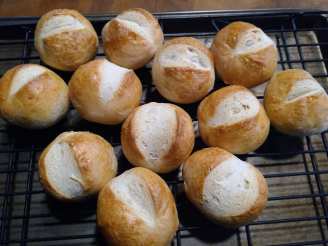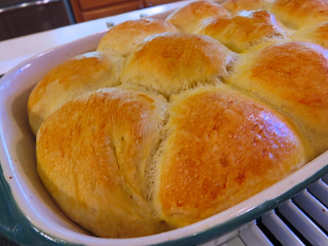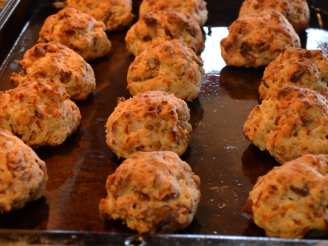Brotchen

- Ready In:
- 3hrs 15mins
- Ingredients:
- 12
- Serves:
-
24
ingredients
- 2 packets active dry yeast
- 2 1⁄2 cups warm water (105-115 degrees)
- 2 tablespoons vegetable shortening
- 1 tablespoon sugar
- 2 teaspoons salt
- 6 -7 cups unbleached all-purpose flour, divided
- 3 egg whites, stiffly beaten
- 1 egg white, beaten with
- 1 tablespoon cold milk
- caraway seeds or sesame seeds (optional)
- coarse salt (optional)
- 1 cup ice cube
directions
- Dissolve yeast in water, in large mixer bowl.
- Using dough hook, blend in shortening, sugar, salt and 3 cups of flour, and beat vigorously for 2 minutes.
- Fold in 3 stiffly beaten egg whites.
- Gradually blend in remaining flour, 1/4 cup at a time, until dough forms a ball and pulls away from the sides of the bowl.
- Turn dough out onto a floured surface and knead for 8-10 minutes, adding more flour as needed to form a smooth, elastic dough, with surface blisters beginning to develop.
- Place into a large warm, oiled bowl, turn to oil all sides of dough.
- Cover with clean tea towel and let rise 1 hour or until doubled in size.
- Turn onto lightly oiled surface.
- Divide into 24 equal pieces and shape into 3-1/2 inch ovals.
- Place on greased baking sheet and flatten slightly.
- Cover with clean towel and let rise about 45 minutes.
- About 15 minutes before end of rising time, turn rolls over.
- Preheat oven to 425 degrees and put an empty shallow pan on the lower shelf.
- Lightly brush brotchen with a mix 1 egg white beaten with milk, and sprinkle with seeds or salt.
- Put ice cubes in the hot pan in lower oven and immediately set pan of brotchen in oven.
- Bake 15-20 minutes or until golden.
- Internal roll temperature should be 190 degrees.
- Transfer to cooling racks.
- If your oven won't hold this number of rolls, shape 1/2 the rolls and let rise, and halfway through the rising time, shape the rest of the dough.
- Bake in two batches.
Questions & Replies
Got a question?
Share it with the community!
Reviews
-
This did not work well for me at all. I tend to make artisinal breads and am usually careful of what I do. The texture of these was somewhat cottony, very little flavor. They looked nice though. I don't think there was enough salt (and that may be a problem since I used the metric conversions which came to 10gm, I think). It would have been better with double that. The amount of yeast was about 3 times more than I would normally use to leaven this much flour, so the dough rose far too fast (even though I tried retarding it in the fridge). The dough also seemed a bit too wet - it never did clear the sides in the mixer. I was OK with it, but it was pretty hard to work with. I don't get why the eggs should be beaten - I understand why they are there, but beating them seemed like an unnecessary step. I can't judge that accurately, since I have never tried any other way. All in all, these are a failure for me.
RECIPE SUBMITTED BY
First of all, since folks always ask, it's pronounced PAN-uh-kuh-nick. It is the name of our valley/ranch, taken from the name of a Klickitat indian leader from long ago. After years as a military spouse & living all over the world, my family and I now live on the ranch where I grew up, miles from nowhere. I am the Snack/Nutrition coordinator for the After School Program in our district, and the one who generally leads the students in any cooking/baking undertakings! While earning my Biology degree at Western Washington University YEARS ago, my kitchen became a popular weekend stop for all my friends, who were more than willing to test my latest culinary experiments!



